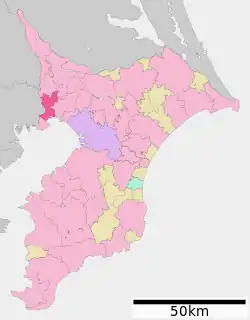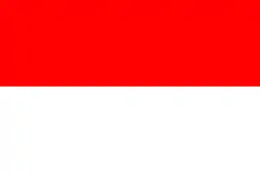Ichikawa, Chiba
Ichikawa City (市川市, Ichikawa-shi) is a city in western Chiba Prefecture, Japan. As of 30 November 2020, the city had an estimated population of 491,804 in 249,313 households and a population density of 8700 persons per km².[1] The total area of the city is 7.45 square kilometres (2.88 sq mi). The city has a concentration of the wide-area traffic network that connects the center of Tokyo with many areas of Chiba Prefecture. Major rail routes and roads pass through the city.
Ichikawa
市川市 | ||||||||
|---|---|---|---|---|---|---|---|---|

| ||||||||
 Flag  Seal | ||||||||
 Location of Ichikawa in Chiba Prefecture | ||||||||
 Ichikawa | ||||||||
| Coordinates: 35°43′18.9″N 139°55′51.8″E | ||||||||
| Country | Japan | |||||||
| Region | Kantō | |||||||
| Prefecture | Chiba | |||||||
| Government | ||||||||
| • Mayor | Hirotami Murakoshi (since April 2018) | |||||||
| Area | ||||||||
| • Total | 56.39 km2 (21.77 sq mi) | |||||||
| Population (November 30, 2020) | ||||||||
| • Total | 491,804 | |||||||
| • Density | 8,700/km2 (23,000/sq mi) | |||||||
| Time zone | UTC+9 (Japan Standard Time) | |||||||
| - Tree | Pinus thunbergii | |||||||
| - Flower | Rose | |||||||
| - Bird | Cettia diphone | |||||||
| Phone number | 047-334-1111 | |||||||
| Address | 1-1-1 Yawata, Ichikawa-shi, Chiba-ken 272-8501 | |||||||
| Website | Official website | |||||||

Geography
Ichikawa is located in the northwestern part of Chiba prefecture, about 20 kilometers from the prefectural capital at Chiba and within 10 to 20 kilometers from the center of Tokyo. The western border of the city is separated from Edogawa Ward of Tokyo by the Edogawa River. The southern part of the city is an alluvial plain about two meters above sea level, and the northern part is part of the gentle Shimosa Plateau rising about 20 meters above sea level. The highest point is 30.1 meters in Satomi Park. Parts of the city are on reclaimed land at sea level.
Climate
Ichikawa has a Humid subtropical climate (Köppen Cfa) characterized by warm summers and cool winters with light to no snowfall. The average annual temperature in Ichikawa is 15.4 °C. The average annual rainfall is 1404 mm with September as the wettest month. The temperatures are highest on average in August, at around 27.0 °C, and lowest in January, at around 4.9 °C.[2]
Demographics
Per Japanese census data,[3] the population of Ichikawa has increased ten-fold over the past century.
| Year | Pop. | ±% |
|---|---|---|
| 1920 | 31,676 | — |
| 1930 | 52,972 | +67.2% |
| 1940 | 75,257 | +42.1% |
| 1950 | 120,565 | +60.2% |
| 1960 | 157,301 | +30.5% |
| 1970 | 261,055 | +66.0% |
| 1980 | 364,244 | +39.5% |
| 1990 | 436,596 | +19.9% |
| 2000 | 448,642 | +2.8% |
| 2010 | 474,926 | +5.9% |
History
The area around present-day Ichikawa has been inhabited since the Japanese Paleolithic period. Archaeologists have found stone tools dating to some 30,000 years ago. Numerous shell middens from the Jōmon period, and hundreds of burial tumuli from the Kofun period have been found in numerous locations around Ichikawa. During the Nara period, Ichikawa was the provincial capital of Shimōsa Province and is mentioned in the Man'yōshū. During the Heian period, this area was the center of the rebellion by Taira Masakado. During the Sengoku period, it was the site of a major battles (Battle of Kōnodai) between the Satomi clan and the Later Hōjō clan.
In more recent history, the area was also the site of some minor battles during the Boshin War of the Meiji Restoration and was promoted as a possible site for the new Diet of Japan by Katsu Kaishu, who envisioned a structure to be built on the Edogawa River similar to the Houses of Parliament in London along the Thames. Ichikawa Town was organized in 1889 with the creation of the modern municipalities system. On November 3, 1934 Ichikawa merged with the neighboring towns of Yawata, Nakayama and village of Kokubun to form the city of Ichikawa. The city expanded by annexing the village of Okashiwa on November 3, 1949, the town of Gyotoku on March 31, 1955 and town of Minami-Gyotoku on October 1, 1956.
Government
Ichikawa has a mayor-council form of government with a directly elected mayor and a unicameral city council of 42 members. Ichikawa contributes six members to the Chiba Prefectural Assembly. In terms of national politics, the city is divided between the Chiba 5th district and the Chiba 6th district of the lower house of the Diet of Japan.
Economy
Ichikawa during the Meiji period was considered a desirable location for politicians, industrialists and many cultural figures, and had the highest assessed land prices in Chiba Prefecture. Many modern writers and poets have either lived in Ichikawa, or had written works set in Ichikawa, including Soseki Natsume, Shiki Masaoka, Akiko Yosano, Yukio Mishima, Nagai Kafu, Hisashi Inoue and Koda Rohan. The area around Ichikawa Station and Motoyawata Station later developed into a commercial area with many high-rise condominiums, commercial facilities, and companies. The area around Motoyawata Station is also an administrative center where many city facilities such as the city hall are located.
The Gyotoku district in the south is an area which once had salt pans in the Edo Period, but was transformed in modern times into new town developments with good access to Tokyo via the Tokyo Metro Tozai Line. The bay area along the Keiyo Line and Japan National Route 357 (Metropolitan Expressway Bayshore Line / Higashi Kanto Expressway) is an industrial area as part of the Tokyo-Chiba industrial zone, and is a distribution base where factories and warehouses of various companies are lined up.
Transportation
Railway
![]() JR East – Chūō-Sōbu Line
JR East – Chūō-Sōbu Line
![]() Keisei Electric Railway - Keisei Main Line
Keisei Electric Railway - Keisei Main Line
- Kōnodai - Ichikawa-Mama - Sugano - Keisei Yawata - Onigoe
![]() Tokyo Metropolitan Bureau of Transportation - Shinjuku Line
Tokyo Metropolitan Bureau of Transportation - Shinjuku Line
![]() Tokyo Metro - Tōzai Line
Tokyo Metro - Tōzai Line
- Kita-Kokubun - <Akiyama - Higashi-Matsudo - Matsuhidai> - Ōmachi
Education
Universities
Primary and secondary schools
- Ichikawa has 39 public elementary schools and three private elementary schools. The city has 27 public middle schools and five private combined middle/high schools, including Ichikawa Gakuen. The city also has seven public high schools and two private high schools.
Twin towns
 Gardena, United States (1962)
Gardena, United States (1962) Issy-les-Moulineaux, France (2012)
Issy-les-Moulineaux, France (2012) Leshan, China (1981)
Leshan, China (1981) Medan, Indonesia (1989)
Medan, Indonesia (1989) Rosenheim, Germany (2004)
Rosenheim, Germany (2004)
Local attractions
- Nakayama Hokekyō-ji: A Buddhist temple with several national important cultural assets, including a gate and a Hokke-dō Hall from the Sengoku period and a Five-story Pagoda built in 1622.
- Katsushika Hachiman Shrine: A Shinto shrine built in the Heian period.
- Osu Disaster Prevention Park: Usually used as a recreation and relaxation site, this park is designated as a temporary evacuation and rescue site in times of disaster.
- Satomi Park: One of Ichikawa's main parks, Satomi Park stands on the hilly part of Konōdai, with the Edo River running below. It is famous for its cherry trees.
- Wild Bird Observatory: This facility is equipped with observation telescopes, and it has an exhibition room which is open to visitors.
- Zoological & Botanical Garden: This garden houses 70 species of animals, mainly small animals such as lesser pandas and orangutans. Nearby is the Natural Museum, Nature Park (Rose Garden), Youth Nature House (Planetarium), and privately managed athletic facilities.
- Teramachi-dori: Formerly called "Narita-michi" ("Narita Road"), this street was once used by pilgrims on their way to Narita-san Temple.
- Guhō-ji and the nearby Mama Well of Kamei-in, mentioned in Takahashi Mushimaro's poem in the Man'yōshū.
- Higashiyama Kaii Memorial Hall: Designed based on Germany, where Higashiyama studied, this two-story building is European in appearance with an octagonal tower.
- Lifelong Learning Center: Nicknamed "Media Park Ichikawa," this center supports learning for everyone from infants to seniors. The center's main attraction is the Central Library, along with the Audio Visual and Children's Hall.
- Clean Spa Ichikawa: Powered by heat from garbage incineration, this facility provides a swimming pool, warm bath, and gymnastic equipment.
Noted people from Ichikawa
- Masa Takanashi, professional wrestler
- Sakaigawa Namiemon, Meiji period sumo wrestler
- Wakashima Gonshirō, Meiji period sumo wrestler
- Kōji Nakano, novelist
- Kuniko Inoguchi, Cabinet minister
- Michio Hoshino, photographer
- Kazuki Kosakai, comedian
- Yūko Andō, newscaster
- Koji Ishikawa, illustrator
- Taiji, musician
- yukihiro (musician), musician
- Kazuo Takahashi, mixed martial artist
- Shigeki Maruyama, professional golfer
- Oginishiki Yasutoshi – sumo wrestler
- Tomo Sakurai, Voice actress
- Tōki Susumu, sumo wrestler
- Ryoji Aikawa, professional baseball player
- Ryoji Aikawa, professional soccer player
- Kazushige Nosawa, professional wrestler
- G.G. Sato, professional baseball player
- Moe Oshikiri, fashion model
- Yuki Abe, professional soccer player
- Atsuko Maeda, singer, actress, former member of AKB48
- Norimitsu Onishi, Journalist
- Tatsuhisa Suzuki, Voice actor
- Peter Takeo Okada, Roman Catholic Archbishop of Tokyo
- Yoko Narahashi, film producer and casting director
- Tao Okamoto, actress and model
References
- "Ichikawa city official statistics" (in Japanese). Japan.
- Ichikawa climate data
- Ichikawa population statistics
- "A Sight-seeing Guide to Ichikawa City's International Exchanges" (PDF). city.ichikawa.lg.jp. Ichikawa. November 2018. Retrieved 2020-04-08.
External links
| Wikimedia Commons has media related to Ichikawa, Chiba. |
- Official Website (in Japanese)